Goodwill is the value of a company or firm in the eyes of the customer. If any business has more market share then it will have a higher value of goodwill.
What is Goodwill: –
When one business acquired a whole or some percentage of a share of another business for the amount which is more than the total assets of that business. That amount of difference which is paid extra is known as goodwill. It is a tangible asset.
Now question is that why business pay extra from the total value of the assets of the business?
There are many reasons for that but some of the important ones are shown as under:
- Higher market share
- More customer reliability
- Satisfied employees
- or have a proprietary technology
In partnership, when a new partner wants to enter into the business the old partners who are going to sacrifice their share of profit in the business for his share, want some amount for the hard work done by them in past to make a profitable business, this amount is treated as goodwill. It is calculated on the basis of the previous year’s profits and losses(if any).
Check out the full article: –
What is Goodwill -Definitions and Factors affecting its value
Chapter No. 3 – Partnership Accounts – II (Goodwill: Nature and Valuation)- USHA Publication Class +2 – Solution
Question-wise solutions of the all Questions of Chapter No. 3 – Partnership Accounts – II (Goodwill: Nature and Valuation)- USHA Publication Class +2 – Solutions are shown below: –
%22%20transform%3D%22translate(.7%20.7)%20scale(1.40625)%22%20fill-opacity%3D%22.5%22%3E%3Cellipse%20fill%3D%22%233cb58c%22%20rx%3D%221%22%20ry%3D%221%22%20transform%3D%22rotate(179.4%2069%206.3)%20scale(191.47452%2017.1125)%22%2F%3E%3Cellipse%20fill%3D%22%23fff%22%20rx%3D%221%22%20ry%3D%221%22%20transform%3D%22matrix(9.21072%2052.6542%20-251.18582%2043.93953%20155%20125.3)%22%2F%3E%3Cellipse%20fill%3D%22%23fff%22%20rx%3D%221%22%20ry%3D%221%22%20transform%3D%22matrix(-2.83511%20-38.6069%20229.75142%20-16.87189%20113.4%20127.4)%22%2F%3E%3Cellipse%20fill%3D%22%23fff%22%20cx%3D%22244%22%20cy%3D%2279%22%20rx%3D%2235%22%20ry%3D%2235%22%2F%3E%3C%2Fg%3E%3C%2Fsvg%3E)
Question 01 Chapter 3 of +2-Part-1 Average Profit Method 1. Rana and Soun are sharing profits 11:9 ratio. Their goodwill ...
%22%20transform%3D%22translate(.7%20.7)%20scale(1.40625)%22%20fill-opacity%3D%22.5%22%3E%3Cellipse%20fill%3D%22%2348bb94%22%20rx%3D%221%22%20ry%3D%221%22%20transform%3D%22matrix(188.2215%20-.26543%20.0446%2031.62721%20123.8%200)%22%2F%3E%3Cellipse%20fill%3D%22%23fff%22%20cx%3D%22136%22%20cy%3D%22108%22%20rx%3D%22255%22%20ry%3D%2242%22%2F%3E%3Cellipse%20fill%3D%22%23fff%22%20rx%3D%221%22%20ry%3D%221%22%20transform%3D%22rotate(168.8%2064.8%2066)%20scale(255%2049.84816)%22%2F%3E%3Cellipse%20fill%3D%22%23dcd1d5%22%20cx%3D%22120%22%20cy%3D%2249%22%20rx%3D%22105%22%20ry%3D%2224%22%2F%3E%3C%2Fg%3E%3C%2Fsvg%3E)
Question 02 Chapter 3 of +2-Part-1 2. (Average Profit Method) Partner X is admitted in the firm of A and ...
%22%20transform%3D%22translate(.7%20.7)%20scale(1.40625)%22%20fill-opacity%3D%22.5%22%3E%3Cellipse%20fill%3D%22%2341b890%22%20rx%3D%221%22%20ry%3D%221%22%20transform%3D%22matrix(-187.07508%202.64801%20-.32613%20-23.04018%20125.2%206.4)%22%2F%3E%3Cellipse%20fill%3D%22%23fff%22%20rx%3D%221%22%20ry%3D%221%22%20transform%3D%22rotate(-4.4%201533.2%20-1305.4)%20scale(255%2059.76474)%22%2F%3E%3Cellipse%20fill%3D%22%23fff%22%20cx%3D%22108%22%20cy%3D%22102%22%20rx%3D%22255%22%20ry%3D%2247%22%2F%3E%3Cellipse%20fill%3D%22%23dfd3d7%22%20cx%3D%2276%22%20cy%3D%2242%22%20rx%3D%22145%22%20ry%3D%2215%22%2F%3E%3C%2Fg%3E%3C%2Fsvg%3E)
Question 03 Chapter 3 of +2-Part-1 3. (Average Profit Method) Calculate goodwill at two years of purchase of average profits ...
%22%20transform%3D%22translate(.7%20.7)%20scale(1.40625)%22%20fill-opacity%3D%22.5%22%3E%3Cellipse%20fill%3D%22%234bbf98%22%20rx%3D%221%22%20ry%3D%221%22%20transform%3D%22matrix(.90258%2036.02669%20-174.09404%204.36157%20129.2%200)%22%2F%3E%3Cellipse%20fill%3D%22%23fff%22%20rx%3D%221%22%20ry%3D%221%22%20transform%3D%22matrix(-251.5759%2041.64812%20-7.25376%20-43.81643%20212.7%20106)%22%2F%3E%3Cellipse%20fill%3D%22%23fff%22%20rx%3D%221%22%20ry%3D%221%22%20transform%3D%22matrix(-252.34769%2036.68303%20-5.1576%20-35.4799%20153.3%20130.3)%22%2F%3E%3Cellipse%20fill%3D%22%23dfd3d7%22%20cx%3D%22131%22%20cy%3D%2265%22%20rx%3D%2279%22%20ry%3D%2232%22%2F%3E%3C%2Fg%3E%3C%2Fsvg%3E)
Question 04 Chapter 3 of +2-Part-1 4. (Average Profit Method) Rani purchased Vani’s business on 31st March 2015. The profit ...
%27%20fill-opacity%3D%27.5%27%3E%3Cellipse%20fill%3D%22%235bbf9d%22%20fill-opacity%3D%22.5%22%20rx%3D%221%22%20ry%3D%221%22%20transform%3D%22matrix(-207.48287%20-.99872%20.21199%20-44.0397%20155.3%209.7)%22%2F%3E%3Cellipse%20fill%3D%22%23fff%22%20fill-opacity%3D%22.5%22%20rx%3D%221%22%20ry%3D%221%22%20transform%3D%22matrix(-355.1905%2049.28676%20-9.98175%20-71.93462%20168.2%20185)%22%2F%3E%3Cellipse%20fill%3D%22%23fff%22%20fill-opacity%3D%22.5%22%20rx%3D%221%22%20ry%3D%221%22%20transform%3D%22matrix(358.29%20-14.7566%202.16273%2052.51115%20225%20167.6)%22%2F%3E%3Cellipse%20fill%3D%22%23dfd0d5%22%20fill-opacity%3D%22.5%22%20rx%3D%221%22%20ry%3D%221%22%20transform%3D%22matrix(168.6142%20-12.23087%203.10535%2042.81016%20151%2083)%22%2F%3E%3C%2Fg%3E%3C%2Fsvg%3E)
Question 05 Chapter 3 of +2-Part-1 5. (Average Profit Method) Goodwill is to be valued at two years purchase of ...
%22%20transform%3D%22translate(.7%20.7)%20scale(1.40625)%22%20fill-opacity%3D%22.5%22%3E%3Cellipse%20fill%3D%22%235cbb9b%22%20rx%3D%221%22%20ry%3D%221%22%20transform%3D%22rotate(.2%2056%2038354)%20scale(166.79443%2041.84873)%22%2F%3E%3Cellipse%20fill%3D%22%23fff%22%20rx%3D%221%22%20ry%3D%221%22%20transform%3D%22rotate(82.9%205.4%20145.5)%20scale(39.56527%20213.89455)%22%2F%3E%3Cellipse%20fill%3D%22%23fff%22%20cx%3D%22172%22%20cy%3D%22121%22%20rx%3D%22255%22%20ry%3D%2231%22%2F%3E%3Cellipse%20fill%3D%22%23d4b3bd%22%20rx%3D%221%22%20ry%3D%221%22%20transform%3D%22matrix(-76.1795%201.59573%20-.19167%20-9.15014%20116.4%2038)%22%2F%3E%3C%2Fg%3E%3C%2Fsvg%3E)
Question 06 Chapter 3 of +2-Part-1 6. (Calculate goodwill when partners capital are given) A firm of partner A, B ...
%22%20transform%3D%22translate(.7%20.7)%20scale(1.40625)%22%20fill-opacity%3D%22.5%22%3E%3Cellipse%20fill%3D%22%2355c39f%22%20rx%3D%221%22%20ry%3D%221%22%20transform%3D%22matrix(.87304%2033.70533%20-159.7991%204.13912%20119.4%200)%22%2F%3E%3Cellipse%20fill%3D%22%23fff%22%20rx%3D%221%22%20ry%3D%221%22%20transform%3D%22matrix(-250.96988%2045.1566%20-7.7779%20-43.22773%20152.8%20121.6)%22%2F%3E%3Cellipse%20fill%3D%22%23fff%22%20rx%3D%221%22%20ry%3D%221%22%20transform%3D%22matrix(.43347%2027.16293%20-251.02814%204.00595%20165.7%20122.2)%22%2F%3E%3Cellipse%20fill%3D%22%23cdb4bd%22%20cx%3D%2267%22%20cy%3D%2234%22%20rx%3D%2299%22%20ry%3D%227%22%2F%3E%3C%2Fg%3E%3C%2Fsvg%3E)
Question 07 Chapter 3 of +2-Part-1 7. (Profit & Loss on fixed asset are given) In a firm of partners ...
%22%20transform%3D%22translate(.7%20.7)%20scale(1.40625)%22%20fill-opacity%3D%22.5%22%3E%3Cellipse%20fill%3D%22%234bc49b%22%20cx%3D%22110%22%20cy%3D%225%22%20rx%3D%22208%22%20ry%3D%2224%22%2F%3E%3Cellipse%20fill%3D%22%23fff%22%20cx%3D%22188%22%20cy%3D%22107%22%20rx%3D%22255%22%20ry%3D%2256%22%2F%3E%3Cellipse%20fill%3D%22%23d2ccce%22%20rx%3D%221%22%20ry%3D%221%22%20transform%3D%22matrix(19.30386%2027.77462%20-20.15926%2014.01105%20170.4%20126)%22%2F%3E%3Cellipse%20fill%3D%22%23fff%22%20cx%3D%2242%22%20cy%3D%22105%22%20rx%3D%22100%22%20ry%3D%2250%22%2F%3E%3C%2Fg%3E%3C%2Fsvg%3E)
Question 08 Chapter 3 of +2-Part-1 8. (Weighted Average Profit Method) The profits of Ram Mills for the last five ...
%22%20transform%3D%22translate(.7%20.7)%20scale(1.40625)%22%20fill-opacity%3D%22.5%22%3E%3Cellipse%20fill%3D%22%235ccca5%22%20rx%3D%221%22%20ry%3D%221%22%20transform%3D%22rotate(89.1%2057.7%2068.8)%20scale(24.07661%20147.06759)%22%2F%3E%3Cellipse%20fill%3D%22%23fff%22%20cx%3D%22241%22%20cy%3D%2287%22%20rx%3D%2267%22%20ry%3D%2238%22%2F%3E%3Cellipse%20fill%3D%22%23f0e3e7%22%20cx%3D%2266%22%20cy%3D%22101%22%20rx%3D%2269%22%20ry%3D%2269%22%2F%3E%3Cellipse%20fill%3D%22%23fff%22%20cx%3D%22244%22%20cy%3D%2281%22%20rx%3D%2255%22%20ry%3D%2231%22%2F%3E%3C%2Fg%3E%3C%2Fsvg%3E)
Question 09 Chapter 3 of +2-Part-1 9. (Weighted Average Profit Method) Calculate the value of goodwill of a firm on ...
%22%20transform%3D%22translate(.7%20.7)%20scale(1.40625)%22%20fill-opacity%3D%22.5%22%3E%3Cellipse%20fill%3D%22%2355cea5%22%20rx%3D%221%22%20ry%3D%221%22%20transform%3D%22rotate(-179.9%2062%204.9)%20scale(188.13289%2018.95602)%22%2F%3E%3Cellipse%20fill%3D%22%23fff%22%20cx%3D%22243%22%20cy%3D%22127%22%20rx%3D%2285%22%20ry%3D%2285%22%2F%3E%3Cpath%20fill%3D%22%23fff%22%20d%3D%22M206.8%20148.8l-10.2-97.5%2076.6-8%2010.2%2097.4z%22%2F%3E%3Cellipse%20fill%3D%22%23fff%22%20rx%3D%221%22%20ry%3D%221%22%20transform%3D%22matrix(-29.10614%208.5664%20-3.94238%20-13.39505%200%2066)%22%2F%3E%3C%2Fg%3E%3C%2Fsvg%3E)
Question 10 Chapter 3 of +2-Part-1 10. (Super Profit Method) A partnership firm earned net profits during the last three ...
%22%20transform%3D%22translate(.7%20.7)%20scale(1.40625)%22%20fill-opacity%3D%22.5%22%3E%3Cellipse%20fill%3D%22%2352c19c%22%20rx%3D%221%22%20ry%3D%221%22%20transform%3D%22matrix(0%2032.74341%20-166.35273%200%20112.8%200)%22%2F%3E%3Cellipse%20fill%3D%22%23fff%22%20rx%3D%221%22%20ry%3D%221%22%20transform%3D%22matrix(254.17861%20-20.45073%203.936%2048.91994%20151.1%20120.9)%22%2F%3E%3Cellipse%20fill%3D%22%23fff%22%20cx%3D%22102%22%20cy%3D%22116%22%20rx%3D%22255%22%20ry%3D%2232%22%2F%3E%3Cellipse%20fill%3D%22%23e0d3d7%22%20rx%3D%221%22%20ry%3D%221%22%20transform%3D%22matrix(-1.667%20-30.11972%20135.88109%20-7.52044%2097.7%2057.9)%22%2F%3E%3C%2Fg%3E%3C%2Fsvg%3E)
Question 11 Chapter 3 of +2- Usha 11. (Super Profit Method) A firm earned net profit during the last five ...
%22%20transform%3D%22translate(.7%20.7)%20scale(1.40625)%22%20fill-opacity%3D%22.5%22%3E%3Cellipse%20fill%3D%22%2350c19b%22%20rx%3D%221%22%20ry%3D%221%22%20transform%3D%22matrix(188.70856%20-4.44303%20.6224%2026.4351%20139.3%202)%22%2F%3E%3Cellipse%20fill%3D%22%23fff%22%20rx%3D%221%22%20ry%3D%221%22%20transform%3D%22matrix(252.85645%20-32.99414%208.76686%2067.18642%20127.8%20131)%22%2F%3E%3Cellipse%20fill%3D%22%23fff%22%20cx%3D%2289%22%20cy%3D%22115%22%20rx%3D%22255%22%20ry%3D%2248%22%2F%3E%3Cellipse%20fill%3D%22%23dcd1d5%22%20rx%3D%221%22%20ry%3D%221%22%20transform%3D%22rotate(-93.5%2078.4%20-28.5)%20scale(24.9829%20106.19939)%22%2F%3E%3C%2Fg%3E%3C%2Fsvg%3E)
Question 12 Chapter 3 of +2-Part-1 12. (Super Profit Method) A firm has total assets of Rs.2,50,000 including cash of ...
%27%20fill-opacity%3D%27.5%27%3E%3Cellipse%20fill%3D%22%2352bf9a%22%20fill-opacity%3D%22.5%22%20rx%3D%221%22%20ry%3D%221%22%20transform%3D%22rotate(-88.3%2063%20-64.2)%20scale(47.2552%20248.07635)%22%2F%3E%3Cellipse%20fill%3D%22%23fff%22%20fill-opacity%3D%22.5%22%20rx%3D%221%22%20ry%3D%221%22%20transform%3D%22matrix(-4.87571%20-66.39459%20357.63074%20-26.26276%20207.4%20156.7)%22%2F%3E%3Cellipse%20fill%3D%22%23fff%22%20fill-opacity%3D%22.5%22%20rx%3D%221%22%20ry%3D%221%22%20transform%3D%22matrix(11.6512%2071.14967%20-334.01376%2054.69685%20190.3%20166)%22%2F%3E%3Cellipse%20fill%3D%22%23dfd1d5%22%20fill-opacity%3D%22.5%22%20rx%3D%221%22%20ry%3D%221%22%20transform%3D%22rotate(-92.8%2089.7%20-16.8)%20scale(30.93136%20237.14395)%22%2F%3E%3C%2Fg%3E%3C%2Fsvg%3E)
Question 13 Chapter 3 of +2-Part-1 13. (Super Profit Method) X and Y have capital of Rs.1,00,000 and Rs.60,000.The reserve ...
%22%20transform%3D%22translate(.7%20.7)%20scale(1.40625)%22%20fill-opacity%3D%22.5%22%3E%3Cellipse%20fill%3D%22%2350c9a0%22%20rx%3D%221%22%20ry%3D%221%22%20transform%3D%22matrix(1.44805%2027.86326%20-165.34225%208.59283%20146.2%200)%22%2F%3E%3Cellipse%20fill%3D%22%23fff%22%20rx%3D%221%22%20ry%3D%221%22%20transform%3D%22matrix(-248.1334%2058.77771%20-10.6889%20-45.1238%20173.9%20117.6)%22%2F%3E%3Cellipse%20fill%3D%22%23fff%22%20cx%3D%22149%22%20cy%3D%22129%22%20rx%3D%22255%22%20ry%3D%2228%22%2F%3E%3Cellipse%20fill%3D%22%23e0d5d8%22%20rx%3D%221%22%20ry%3D%221%22%20transform%3D%22matrix(-100.59092%2013.95814%20-4.44919%20-32.06355%20105.4%2074.7)%22%2F%3E%3C%2Fg%3E%3C%2Fsvg%3E)
Question 14 Chapter 3 of +2-Part-1 14. (Super Profit Method) Calculate goodwill at two years purchase of super-profits. Normal rate ...
%22%20transform%3D%22translate(.7%20.7)%20scale(1.40625)%22%20fill-opacity%3D%22.5%22%3E%3Cellipse%20fill%3D%22%234fc59c%22%20rx%3D%221%22%20ry%3D%221%22%20transform%3D%22matrix(-.4846%20-21.66001%20178.44339%20-3.99226%20143.1%208.5)%22%2F%3E%3Cellipse%20fill%3D%22%23fff%22%20rx%3D%221%22%20ry%3D%221%22%20transform%3D%22matrix(253.04929%20-31.48107%205.92262%2047.60684%20137.6%20123)%22%2F%3E%3Cellipse%20fill%3D%22%23fff%22%20cx%3D%22162%22%20cy%3D%22117%22%20rx%3D%22255%22%20ry%3D%2238%22%2F%3E%3Cellipse%20fill%3D%22%23dfd3d7%22%20rx%3D%221%22%20ry%3D%221%22%20transform%3D%22matrix(131.8499%20-8.17233%201.7403%2028.07745%2099.8%2056.2)%22%2F%3E%3C%2Fg%3E%3C%2Fsvg%3E)
Question 15 Chapter 3 of +2-Part-1 15. (Capitalisation Method) The average net profits expected in future by Ram Gopal and ...
%27%20fill-opacity%3D%27.5%27%3E%3Cellipse%20fill%3D%22%234ec79e%22%20fill-opacity%3D%22.5%22%20rx%3D%221%22%20ry%3D%221%22%20transform%3D%22matrix(-.12865%20-23.59034%20247.93642%20-1.3521%20188.7%2013.2)%22%2F%3E%3Cellipse%20fill%3D%22%23fff%22%20fill-opacity%3D%22.5%22%20rx%3D%221%22%20ry%3D%221%22%20transform%3D%22matrix(-3.27153%20-59.99963%20358.06187%20-19.52361%20157.3%20166.9)%22%2F%3E%3Cellipse%20fill%3D%22%23fff%22%20fill-opacity%3D%22.5%22%20rx%3D%221%22%20ry%3D%221%22%20transform%3D%22matrix(4.64053%2055.26255%20-357.3361%2030.00635%20245.7%20156.4)%22%2F%3E%3Cellipse%20fill%3D%22%23dcd7d9%22%20fill-opacity%3D%22.5%22%20rx%3D%221%22%20ry%3D%221%22%20transform%3D%22rotate(178.3%2070%2037.2)%20scale(189.0842%2040.39783)%22%2F%3E%3C%2Fg%3E%3C%2Fsvg%3E)
Question 16 Chapter 3 of +2-Part-1 16. (Capitalisation Method) A firm earns Rs.1,00,000 as its annual profits, the rate of ...
%27%20fill-opacity%3D%27.5%27%3E%3Cellipse%20fill%3D%22%2352cca2%22%20fill-opacity%3D%22.5%22%20rx%3D%221%22%20ry%3D%221%22%20transform%3D%22scale(264.26908%2026.07939)%20rotate(90%20.1%20.7)%22%2F%3E%3Cellipse%20fill%3D%22%23fff%22%20fill-opacity%3D%22.5%22%20rx%3D%221%22%20ry%3D%221%22%20transform%3D%22rotate(-4.5%202310.2%20-2169.3)%20scale(358.59375%2051.48841)%22%2F%3E%3Cellipse%20fill%3D%22%23fff%22%20fill-opacity%3D%22.5%22%20rx%3D%221%22%20ry%3D%221%22%20transform%3D%22matrix(342.60129%20-105.8954%2019.33147%2062.54271%20254.4%20165.3)%22%2F%3E%3Cellipse%20fill%3D%22%23ded3d7%22%20fill-opacity%3D%22.5%22%20rx%3D%221%22%20ry%3D%221%22%20transform%3D%22matrix(-3.9508%20-43.36166%2071.67586%20-6.53059%20237%2087.2)%22%2F%3E%3C%2Fg%3E%3C%2Fsvg%3E)
Question 17 Chapter 3 of +2-Part-1 17. (Capitalisation Method) The average net profits expected in future by Ram Gopal and ...
%22%20transform%3D%22translate(.7%20.7)%20scale(1.40625)%22%20fill-opacity%3D%22.5%22%3E%3Cellipse%20fill%3D%22%234fc9a0%22%20rx%3D%221%22%20ry%3D%221%22%20transform%3D%22matrix(-225.40437%20-4.32799%20.46957%20-24.45561%2085.8%20.8)%22%2F%3E%3Cellipse%20fill%3D%22%23fff%22%20rx%3D%221%22%20ry%3D%221%22%20transform%3D%22rotate(90.6%2016.2%20138)%20scale(34.4068%20249.45298)%22%2F%3E%3Cellipse%20fill%3D%22%23fff%22%20rx%3D%221%22%20ry%3D%221%22%20transform%3D%22rotate(-6.3%201197.7%20-1211.8)%20scale(255%2036.98753)%22%2F%3E%3Cellipse%20fill%3D%22%23fff%22%20cx%3D%22240%22%20cy%3D%2288%22%20rx%3D%2228%22%20ry%3D%2244%22%2F%3E%3C%2Fg%3E%3C%2Fsvg%3E)
Question 18 Chapter 3 of +2-Part-1 18. (Capitalisation of super profit) The assets of a firm are Rs.26,000 and liabilities ...
%27%20fill-opacity%3D%27.5%27%3E%3Cellipse%20fill%3D%22%2359c4a0%22%20fill-opacity%3D%22.5%22%20rx%3D%221%22%20ry%3D%221%22%20transform%3D%22matrix(2.04712%2040.80018%20-205.05694%2010.28858%20187.2%2010.4)%22%2F%3E%3Cpath%20fill%3D%22%23fff%22%20fill-opacity%3D%22.5%22%20d%3D%22M379%2051.3l-22.5%20173-378.3-28.1z%22%2F%3E%3Cellipse%20fill%3D%22%23fff%22%20fill-opacity%3D%22.5%22%20rx%3D%221%22%20ry%3D%221%22%20transform%3D%22matrix(-27.0302%20-78.47533%20214.72828%20-73.96146%20280%20176.8)%22%2F%3E%3Cellipse%20fill%3D%22%23c6b3b9%22%20fill-opacity%3D%22.5%22%20rx%3D%221%22%20ry%3D%221%22%20transform%3D%22matrix(.85713%2013.25457%20-107.99778%206.9839%20138.7%2053)%22%2F%3E%3C%2Fg%3E%3C%2Fsvg%3E)
Question 19 Chapter 3 of +2-Part-1 18. (Avg Profit/ Super Profit/Capitalisation method) The following information relates to a partnership firm: ...
%22%20transform%3D%22translate(.7%20.7)%20scale(1.40625)%22%20fill-opacity%3D%22.5%22%3E%3Cellipse%20fill%3D%22%2355c29d%22%20rx%3D%221%22%20ry%3D%221%22%20transform%3D%22matrix(-.88846%2033.22996%20-161.06063%20-4.30625%20101.7%200)%22%2F%3E%3Cellipse%20fill%3D%22%23fff%22%20rx%3D%221%22%20ry%3D%221%22%20transform%3D%22rotate(81.9%2024.4%20158.2)%20scale(45.44931%20254.99999)%22%2F%3E%3Cellipse%20fill%3D%22%23fff%22%20cx%3D%22114%22%20cy%3D%22119%22%20rx%3D%22255%22%20ry%3D%2230%22%2F%3E%3Cellipse%20fill%3D%22%23ddd0d4%22%20rx%3D%221%22%20ry%3D%221%22%20transform%3D%22matrix(-104.58759%205.90632%20-1.80176%20-31.90512%2098%2059.6)%22%2F%3E%3C%2Fg%3E%3C%2Fsvg%3E)
Question 20 Chapter 3 of +2-Part-1 20. (Super Profit/Capitalisation method) A firm earns a profit of Rs.5,000 per year. The ...
%22%20transform%3D%22matrix(5%200%200%205%202.5%202.5)%22%20fill-opacity%3D%22.5%22%3E%3Cellipse%20fill%3D%22%2349c49a%22%20rx%3D%221%22%20ry%3D%221%22%20transform%3D%22matrix(243.6976%206.80709%20-.69599%2024.91672%2045%200)%22%2F%3E%3Cellipse%20fill%3D%22%23fff%22%20rx%3D%221%22%20ry%3D%221%22%20transform%3D%22rotate(-7%20977.2%20-1262.7)%20scale(191.40456%2062.21309)%22%2F%3E%3Cellipse%20fill%3D%22%23fff%22%20cx%3D%22140%22%20cy%3D%22129%22%20rx%3D%2286%22%20ry%3D%2286%22%2F%3E%3Cellipse%20fill%3D%22%23d7d1d3%22%20rx%3D%221%22%20ry%3D%221%22%20transform%3D%22matrix(-41.32818%20-6.2503%204.87228%20-32.21644%2038%2055.3)%22%2F%3E%3C%2Fg%3E%3C%2Fsvg%3E)
Question 22 Chapter 3 of USHA Publication 12 Class Part - 1 22. (Super Profit Method) A partnership firm earned ...
%22%20transform%3D%22matrix(5%200%200%205%202.5%202.5)%22%20fill-opacity%3D%22.5%22%3E%3Cellipse%20fill%3D%22%234ac49a%22%20cx%3D%22122%22%20cy%3D%2211%22%20rx%3D%22239%22%20ry%3D%2216%22%2F%3E%3Cellipse%20fill%3D%22%23fff%22%20rx%3D%221%22%20ry%3D%221%22%20transform%3D%22rotate(-89.9%20128.3%20-13.8)%20scale(43.54133%20255.00001)%22%2F%3E%3Cellipse%20fill%3D%22%23fff%22%20rx%3D%221%22%20ry%3D%221%22%20transform%3D%22rotate(175.3%2075.5%2059.2)%20scale(255%2041.13776)%22%2F%3E%3Cellipse%20fill%3D%22%23ded3d7%22%20cx%3D%22121%22%20cy%3D%2251%22%20rx%3D%22113%22%20ry%3D%2226%22%2F%3E%3C%2Fg%3E%3C%2Fsvg%3E)
Question 24 Chapter 3 of USHA Publication 12 Class Part - 1 24. (Calculation of Super Profits and Average Profits ...
%22%20transform%3D%22matrix(5%200%200%205%202.5%202.5)%22%20fill-opacity%3D%22.5%22%3E%3Cellipse%20fill%3D%22%2347c298%22%20cx%3D%22107%22%20rx%3D%22255%22%20ry%3D%2226%22%2F%3E%3Cellipse%20fill%3D%22%23fff%22%20rx%3D%221%22%20ry%3D%221%22%20transform%3D%22rotate(-98.3%20106.4%2015.7)%20scale(61.9539%20247.22632)%22%2F%3E%3Cellipse%20fill%3D%22%23fff%22%20rx%3D%221%22%20ry%3D%221%22%20transform%3D%22rotate(-7.9%20863%20-1132.4)%20scale(255%2051.36472)%22%2F%3E%3Cellipse%20fill%3D%22%23d8d3d4%22%20cx%3D%2293%22%20cy%3D%2240%22%20rx%3D%22147%22%20ry%3D%2217%22%2F%3E%3C%2Fg%3E%3C%2Fsvg%3E)
Question 25 Chapter 3 of USHA Publication 12 Class Part - 1 25. (Average Profits Method/When profits are given) B ...
%22%20transform%3D%22matrix(5%200%200%205%202.5%202.5)%22%20fill-opacity%3D%22.5%22%3E%3Cellipse%20fill%3D%22%234bc49b%22%20rx%3D%221%22%20ry%3D%221%22%20transform%3D%22rotate(88.9%2065.7%2074)%20scale(19.32934%20249.98693)%22%2F%3E%3Cellipse%20fill%3D%22%23fff%22%20rx%3D%221%22%20ry%3D%221%22%20transform%3D%22matrix(-251.79052%2040.3303%20-7.80482%20-48.72712%20154.4%20113)%22%2F%3E%3Cellipse%20fill%3D%22%23fff%22%20rx%3D%221%22%20ry%3D%221%22%20transform%3D%22matrix(254.10568%20-21.33785%203.58177%2042.65417%20142.6%20113)%22%2F%3E%3Cellipse%20fill%3D%22%23ddd2d5%22%20cx%3D%2295%22%20cy%3D%2248%22%20rx%3D%22108%22%20ry%3D%2224%22%2F%3E%3C%2Fg%3E%3C%2Fsvg%3E)
Question 26 Chapter 3 of USHA Publication 12 Class Part - 1 26. (Capitalisation of S.P./S.P. Method) A business has ...



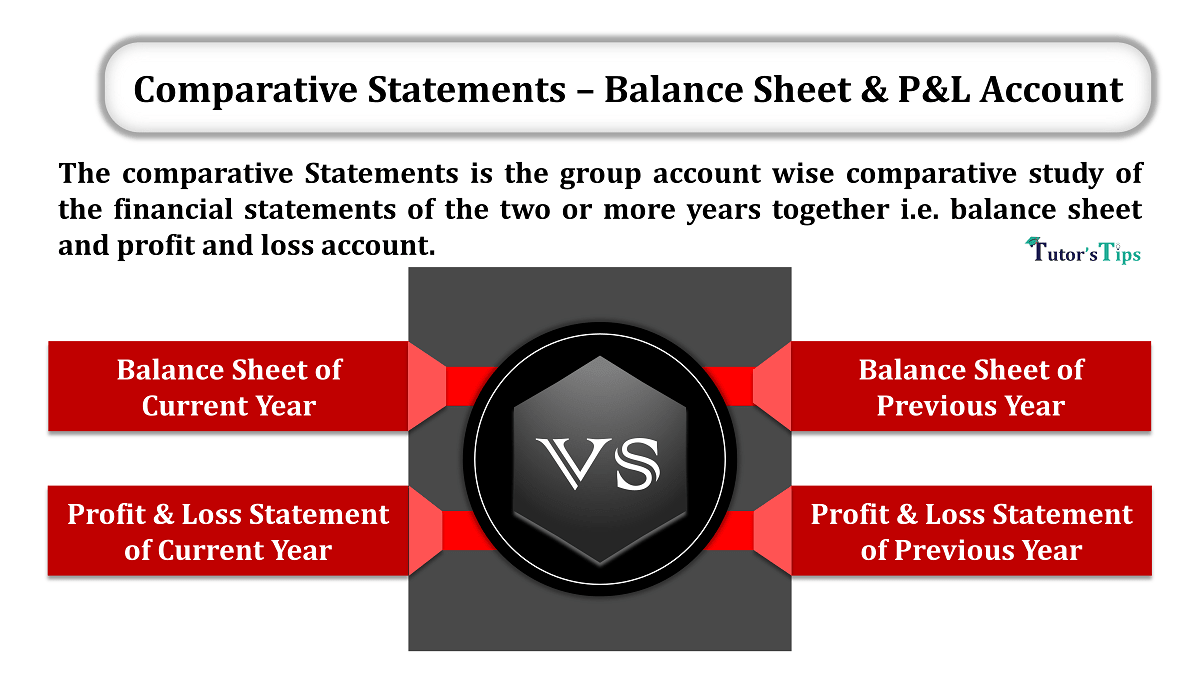



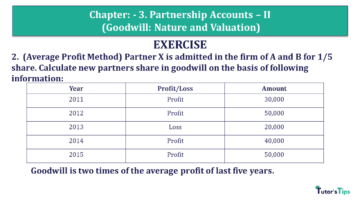
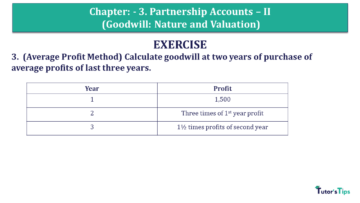


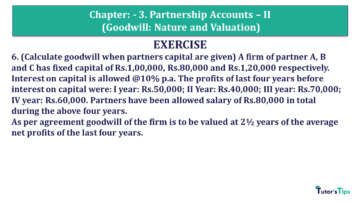


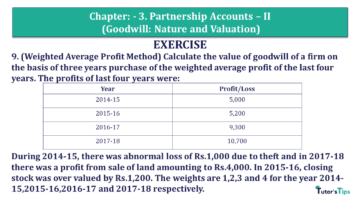


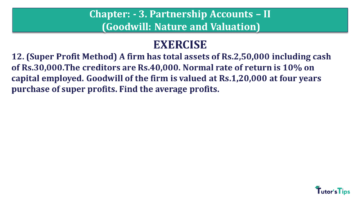
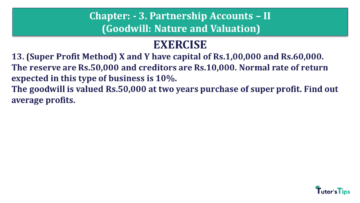

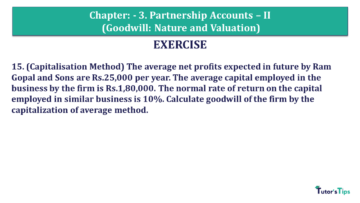
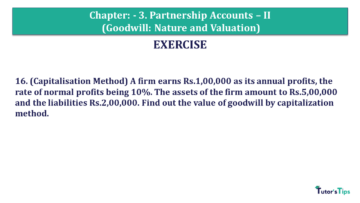
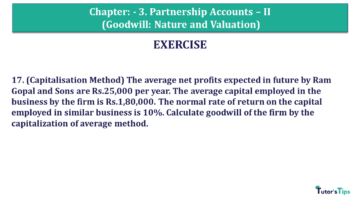

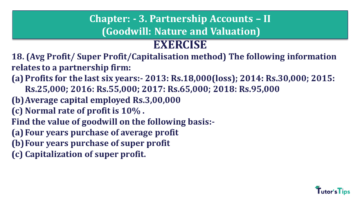
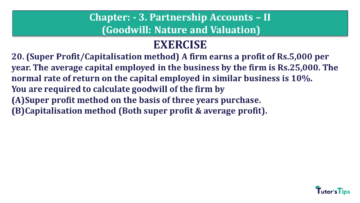

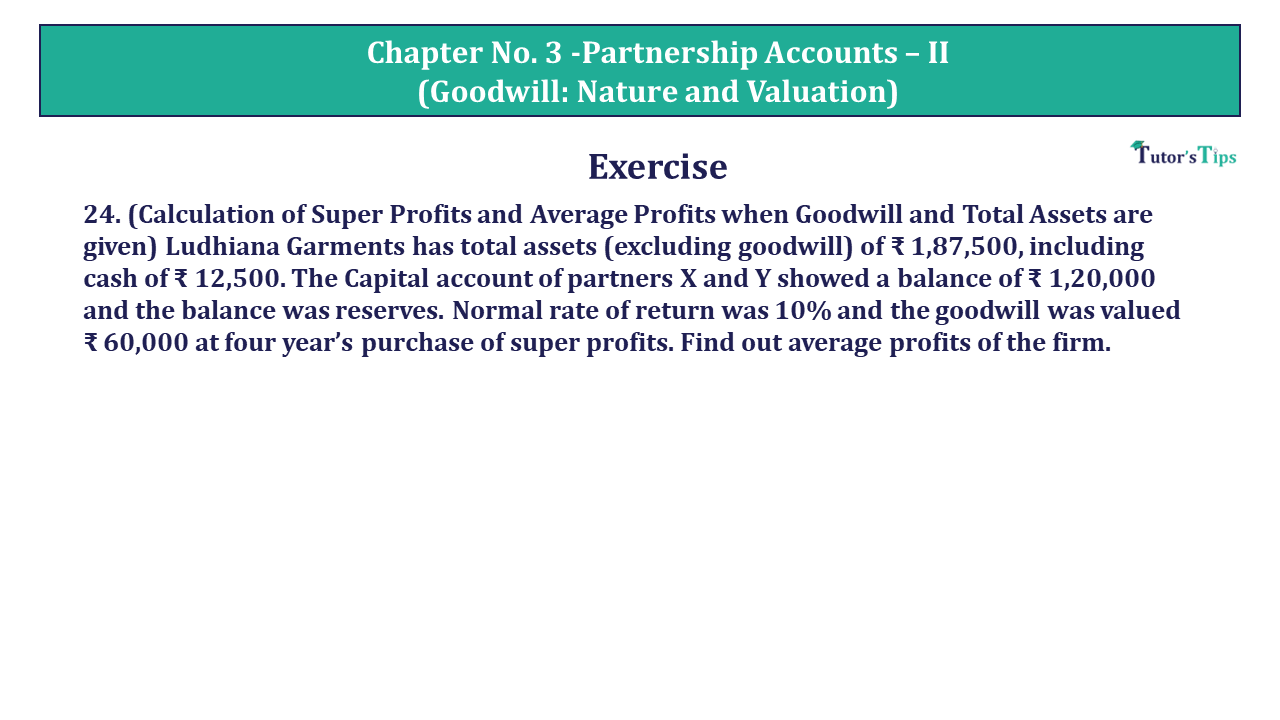

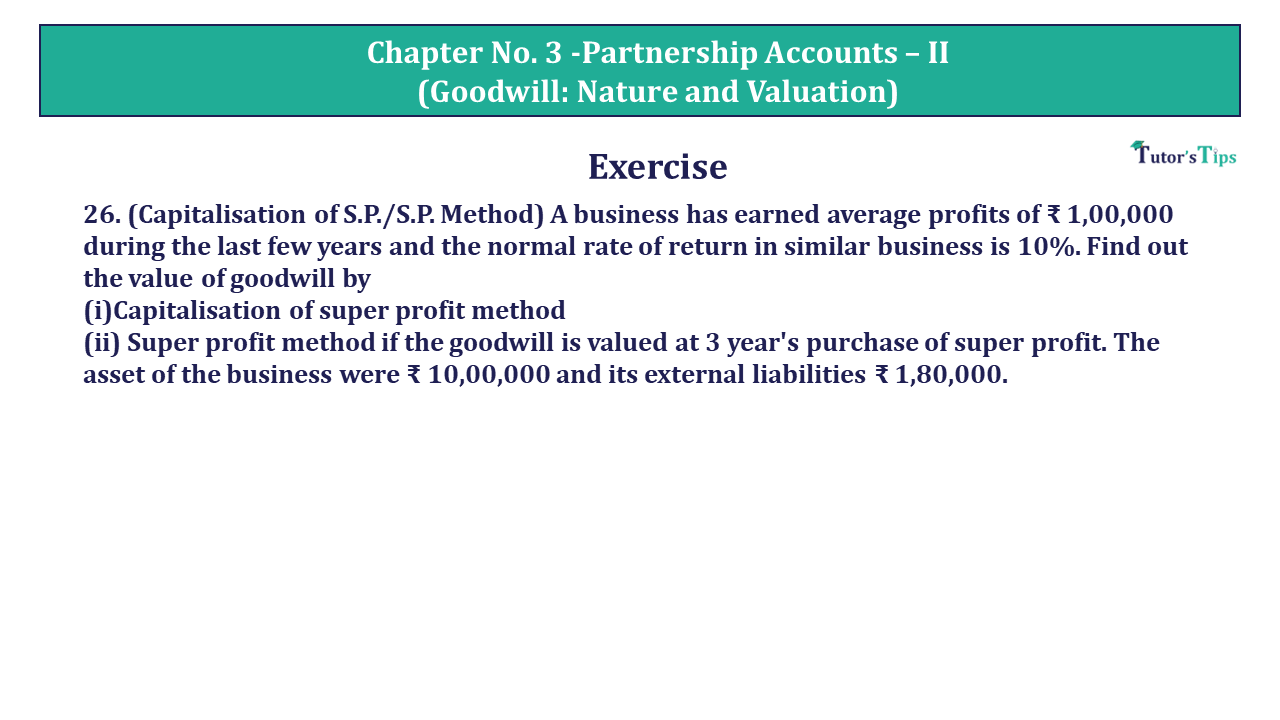
Hello please explain the volume 3 MCQ
We will do it soon.
Please answer question number 22 of new book
we will solve it soon.
you can also check it from our youtube channel for full book solution in video format for free of cost.
https://www.youtube.com/TutorsTips
Pls explain illustration no. 13 of chapter (Goodwill: nature and Valuation)
ILLUSTRATION 13. (Capitalisation Method/Both) A firm has total assets worth
ear € 5,00,000 and external liabilities ₹1,00,000. The normal rate of return is 10%. The actual
On of profits earned by the firm amounts to 60,000. Find out the value of goodwill under : (a)
Capitalisation of super profit method and (b) Capitalisation of average profit method.
please tell your problem what you did not understand in this illustration
or you can check our video on this topic
https://youtu.be/09APPIuMoSs
Navjot gill iam commerce student
okay, good
keep in touch.
you can learn all subjects here.
Solution for
Hello Rajvinder
How I can help you?
Hello Rajvinder,
For what you want solution can you please explain?
Please explain miscellaneous problems of class 12th Usha publication ch 3.
We will explained them soon